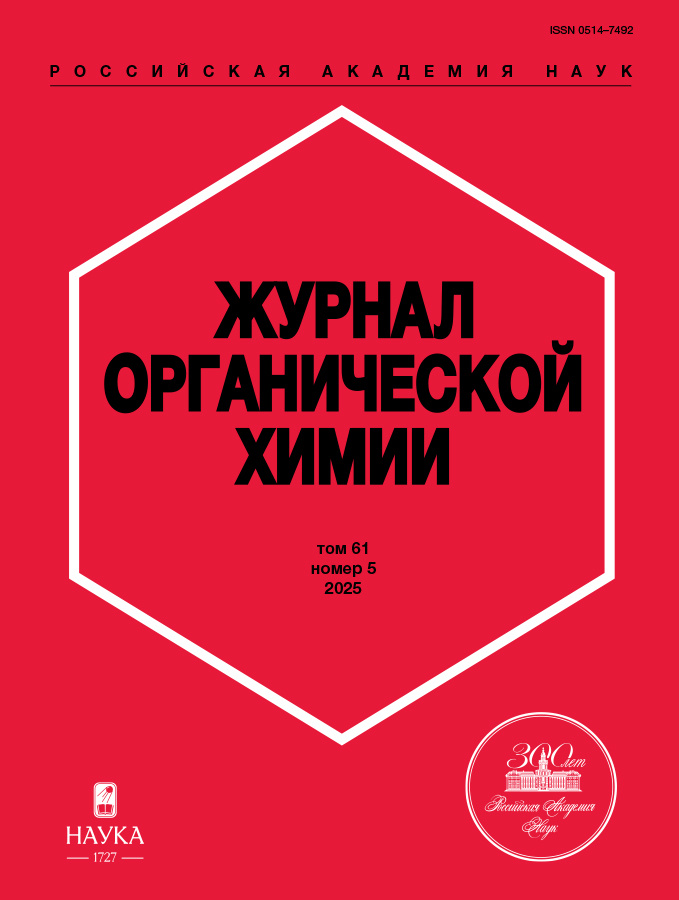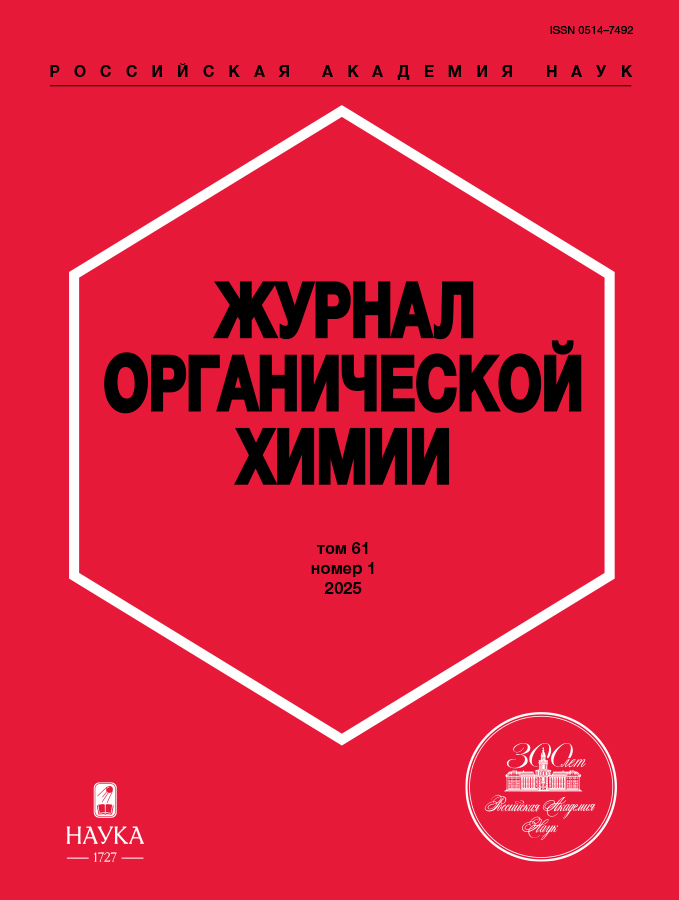Динамическая структура молекул в растворе по данным спектроскопии ЯМР и квантово-химических расчетов: V. Конформация и кисотно-основные равновесия производных бензилиденанилина
- Авторы: Станишевский В.В.1, Шестакова А.К.2, Чертков В.А.1
-
Учреждения:
- Московский государственный университет имени М.В. Ломоносова
- Государственный научно-исследовательский институт химии и технологии элементоорганических соединений
- Выпуск: Том 61, № 1 (2025)
- Страницы: 55-68
- Раздел: ЭКСПЕРИМЕНТАЛЬНЫЕ СТАТЬИ
- URL: https://clinpractice.ru/0514-7492/article/view/682054
- DOI: https://doi.org/10.31857/S0514749225010039
- EDN: https://elibrary.ru/AFZGYW
- ID: 682054
Цитировать
Полный текст
Аннотация
Исследована динамика заторможенного внутреннего вращения бензольных колец производных бензилиденанилина и их протонированных форм с использованием спектроскопии ЯМР и квантово-механических расчетов. Для серии [15N]-обогащенных производных бензилиденанилина с заместителями в орто-положении бензольного кольца при карбамидном атоме углерода определены константы спин-спинового взаимодействия 15N–1Н и 15N–13C. Показано, что конформация этих молекул сильно зависит от характера заместителей. При этом группа CH3 слабо влияет на конформацию молекулы при переходе от нейтральной формы к протонированной форме. Напротив, для соединений с заместителями F, OH и OCH3 наблюдается дополнительная стабилизация протонированной формы (6–7 ккал/моль) за счет образования водородной связи гетероатома заместителя с протоном при азометиновом азоте. Это приводит к повороту замещенного бензольного кольца на 180°. Эффект смены конформации при протонировании молекул этого типа может быть использован для конструирования новых pH-индуцированных молекулярных переключателей. Энергия pH-индуцированного молекулярного переключения [15N]-2-фтор бензилиденанилина составляет ~ 7 ккал/моль, что является одним из самых высоких значений для pH-индуцированных молекулярных переключателей.
Полный текст
Об авторах
В. В. Станишевский
Московский государственный университет имени М.В. Ломоносова
Email: vchertkov@hotmail.com
ORCID iD: 0009-0004-5955-8233
Россия, Ленинские горы, 1, Москва, 119991
А. К. Шестакова
Государственный научно-исследовательский институт химии и технологии элементоорганических соединений
Автор, ответственный за переписку.
Email: vchertkov@hotmail.com
ORCID iD: 0000-0002-2252-6914
Россия, шоссе Энтузиастов, 38, Москва, 105118
В. А. Чертков
Московский государственный университет имени М.В. Ломоносова
Email: vchertkov@hotmail.com
ORCID iD: 0000-0001-8699-5894
Россия, Ленинские горы, 1, Москва, 119991
Список литературы
- Станишевский В.В., Шестакова А.К., Чертков В.А., ЖОрХ, 2023, 59 (8), 1012–1024. doi: 10.31857/S0514749223080025
- Шестакова А.К., Станишевский В.В., Чертков В.А., Химия гетероцикл. Соединений, 2023, 59 (9/10), 657–665. doi: 10.1007/s10593-023-03251-6
- Cheshkov D.A., Sinitsyn D.O., Sheberstov K.F., Chertkov V.A., J. Magn. Reson., 2016, 272, 10–19. doi: 10.1016/j.jmr.2016.08.012
- Cheshkov D.A., Sheberstov K.F., Sinitsyn D.O., Chertkov V.A., Magn. Reson. Chem., 2018, 56 (6), 449–457. doi: 10.1002/mrc.4689
- Martin G.E., Williams A.J., eMagRes., 2010, 1–42. doi: 10.1002/9780470034590.emrstm1083
- Stanishevskiy V.V., Shestakova A.K., Chertkov V.A., Appl. Magn. Reson., 2022, 53, 1693–1713. doi: 10.1007/s00723-022-01503-w
- Schneider H.-J., Molecules. 2024, 29, 1591–1603. doi: 10.3390/molecules29071591
- Muzalevskiy V.M., Mamedzade M.N., Chertkov V.A., Bakulev V.A., Nenajdenko V.G., Mendeleev Commun. 2018, 28 (1), 17–19. doi: 10.1016/j.mencom.2018.01.003
- Muzalevskiy V.M., Sizova Z.A., Panyushkin V.V., Chertkov V.A., Khrustalev V.N., Nenajdenko V.G., J. Org. Chem. 2021, 86, 2385–2405. doi: 10.1021/acs.joc.0c02516
- Schneider H-J., Angew. Chem. Int. Ed., Engl. 1991, 30, 1417–1436. doi: 10.1002/anie.199114171
- Merino E., Ribagorda, Beilstein M., J. Org. Chem. 2012, 8, 1071–1090. doi: 10.3762/bjoc.8.119
- Ni X., Liang Z., Ling J., Li X., Shen Z. Polym. Int. 2011, 60, 12, 1745–1752. doi: 10.1002/pi.3145
- Meister E.C., Willeke M., Angst W., Togni A., Walde P. Helv. Chim. Acta. 2014, 97 (1), 1–31. doi: 10.1002/hlca.201300321
- Foresman J.B., Frisch A., “Exploring Chemistry With Electronic Structure Methods”, 3rd edition 2015, “Gaussian Inc.”, Pittsburgh, 354 p. ISBN: 978-1-935522-03-4
- Frisch M.J., Trucks G.W., Schlegel H.B., Scuser G.E., Robb M.A., Cheeseman J.R., Scalmani G., Barone V., Mennucci B., Petersson G.A., Nakatsuji H., Caricato M., Li X., Hratchian H.P., Izmaylov A.F., Bloino J., Zheng G., Sonnenberg J.L., Hada M., Ehara M., Toyota K., Fukuda R., Hasegawa J., Ishida M., Nakajima T., Honda Y., Kitao O., Nakai H., Vreven T., Montgomery J.A., Jr., Peralta J.E., Ogliaro F., Bearpark M., Heyd J.J., Brothers E., Kudin K.N., Staroverov V.N., Kobayashi R., Normand J., Raghavachari K., Rendell A., Burant J.C., Iyengar S.S., Tomasi J., Cossi M., Rega N., Millam J.M., Klene M., Knox J.E., Cross J.B., Bakken V., Adamo C., Jaramillo J., Gomperts R., Stratmann R.E., Yazyev O., Austin A.J., Cammi R., Pomelli C., Ochterski J.W., Martin R.L., Morokuma K., Zakrzewski V.G., Voth G.A., Salvador P., Dannenberg J.J., Dapprich S., Daniels A.D., Farkas O., Foresman J.B., Ortiz J.V., Cioslowski J., Fox D.J., “Gaussian 09W, Revision A.02”, Gaussian, Inc., Wallingford, 2009.
- Samoshin V.V., Brazdova B., Chertkov V.A., Gremyachinskiy D.E., Shestakova A.K., Dobretsova E.K, Vatlina L.P., Yuan J., Schneider H.-J., ARKIVOC. 2005, 4, 129–141. doi: 10.3998/ark.5550190.0006.410
- Samoshin V.V., Chertkov V.A., Gremyachinskiy D.E., Shestakova A.K., Dobretsova E.K., Vatlina L.P., Schneider H.-J., Tetrahedron Lett. 2004, 45, 7823–7826. doi: 10.1016/j.tetlet.2004.09.004
- Samoshin A.V., Veselov I.S., Huynh L., Shestakova A.K., Chertkov V.A., Grishina G.V., Samoshin V.V. Tetrahedron Lett. 2011, 52 (41), 5375–5378. doi: 10.1016/j.tetlet.2011.08.038
- Wang Z., Islam M.J., Vukotic V.N., Revington M.J, J. Org. Chem., 2016, 81 (7), 2981–62981. doi: 10.1021/acs.joc.6b00250
- Gunther H., NMR Spectroscopy, Basic principles, concepts and applications in chemistry, 3rd edn., Weinheim: Wiley-VCH 2013. ISBN 978-3-527-33000-3.
- Kaupp M.B., Malkin V.G., Calculation of NMR and EPR parameter. Theory and applications, Weinheim: Wiley-VCH 2004.
- Claridge T.D.W., High-resolution NMR techniques in organic chemistry, 3rd edn., Oxford: Elsevier Science 2016. ISBN 978-0-08-099986-9.
- Berger S., Braun S., 200 and more NMR experiments: a practical course, Oxford–Weinheim: Wiley-VCH 2004. ISBN 3-527-31067-3.
- Chertkov V.A., Shestakova A.K., Davydov D.V. Chem. Heterocycl. Compd. 2011, 47, 45–54. doi: 10.1007/s10593-011-0718-z
- Uvarov V.A., Chertkov V.A., Sergeyev N.M. J. Chem. Soc. Perkin. Trans. II. 1994, 2, 2375–2378. doi: 10.1039/P29940002375
- Morgan W.D., Birdsall V, Nieto P.M., Gargaro A.R., Feeney J. Biochemistry. 1999, 38, 2127–2134. doi: 10.1021/bi982359u
- Williamson R.T., Buevich A.V., Martin G.E. Tetrahedron Lett. 2014, 55, 3365–3366. doi: 10.1016/j.tetlet.2014.04.060
- Deng W., Cheeseman J.R., Frisch M.J. J. Chem. Theory Comput. 2006, 2, 1028–1037. doi: 10.1021/ct600110u
- Программный комплекс ChemSketch 6.0, AcdLabs, 2025
Дополнительные файлы























